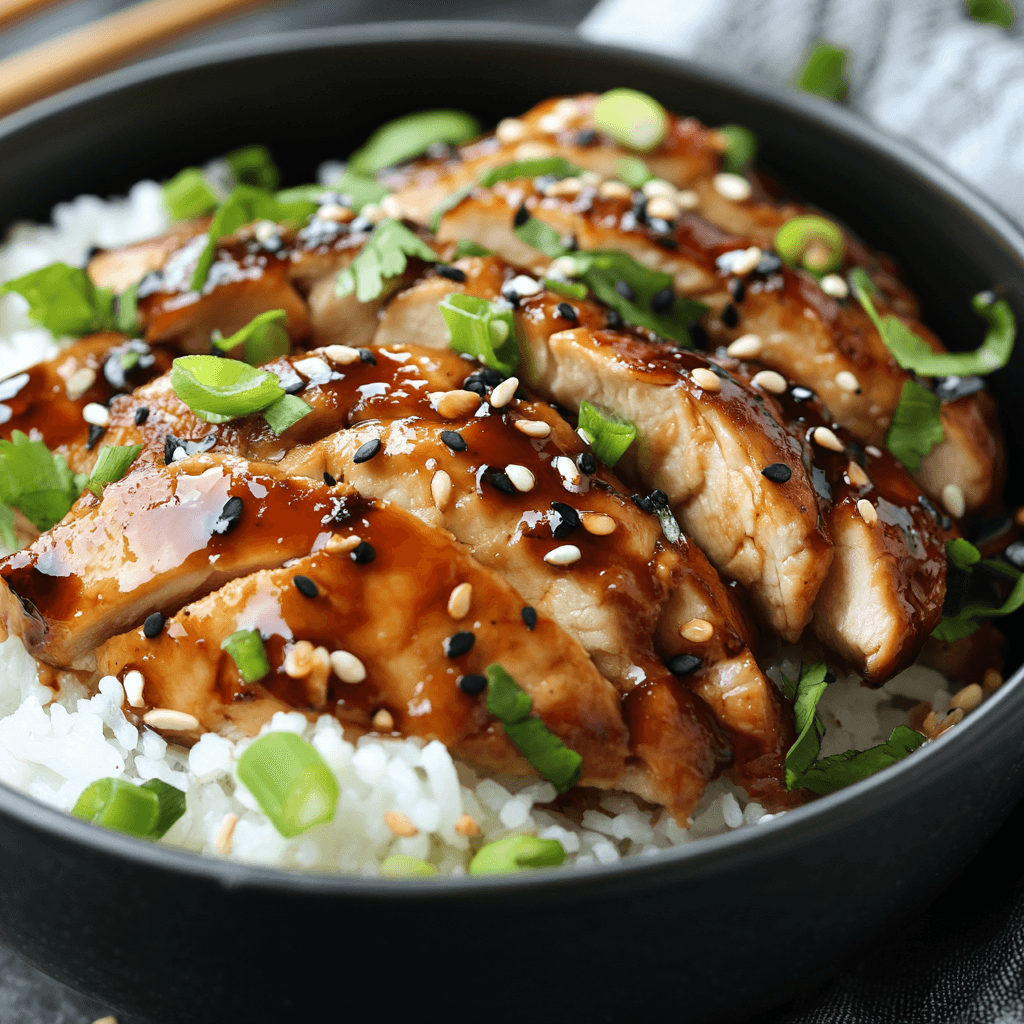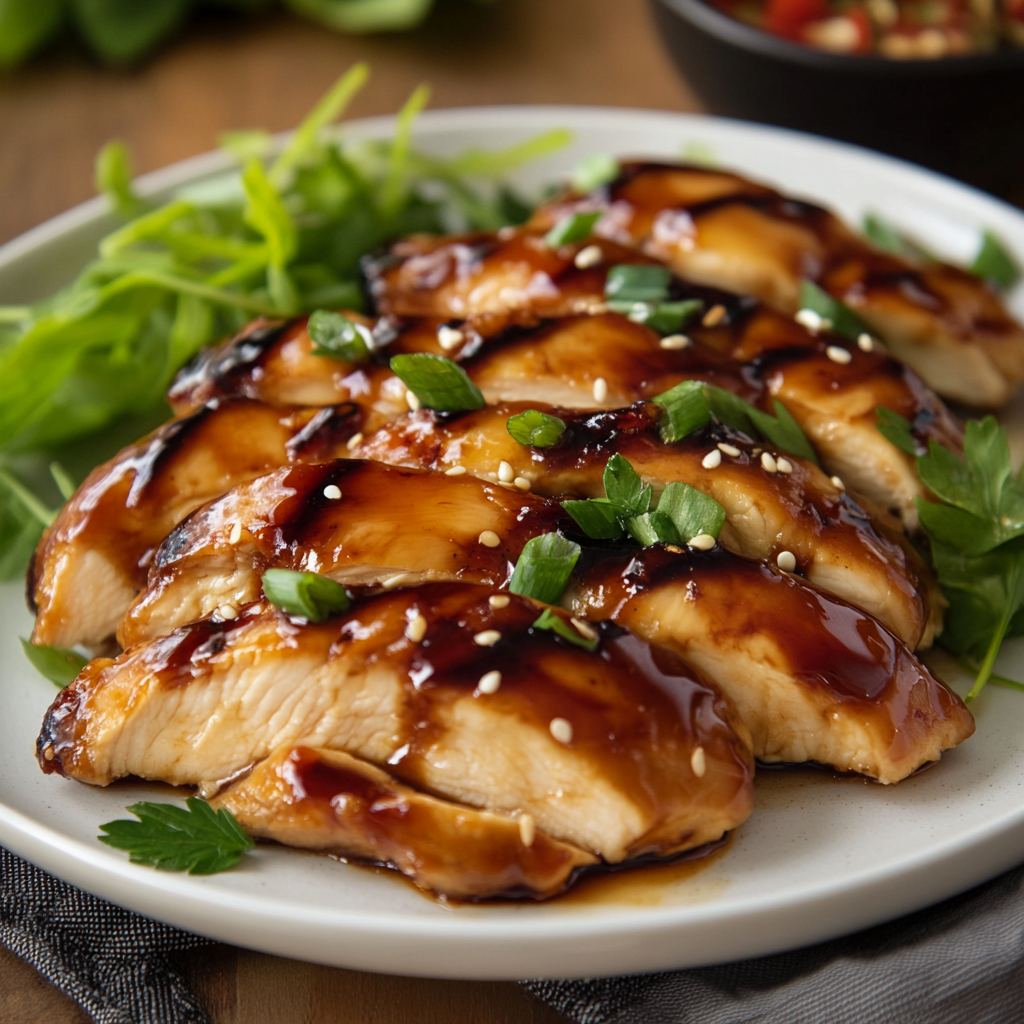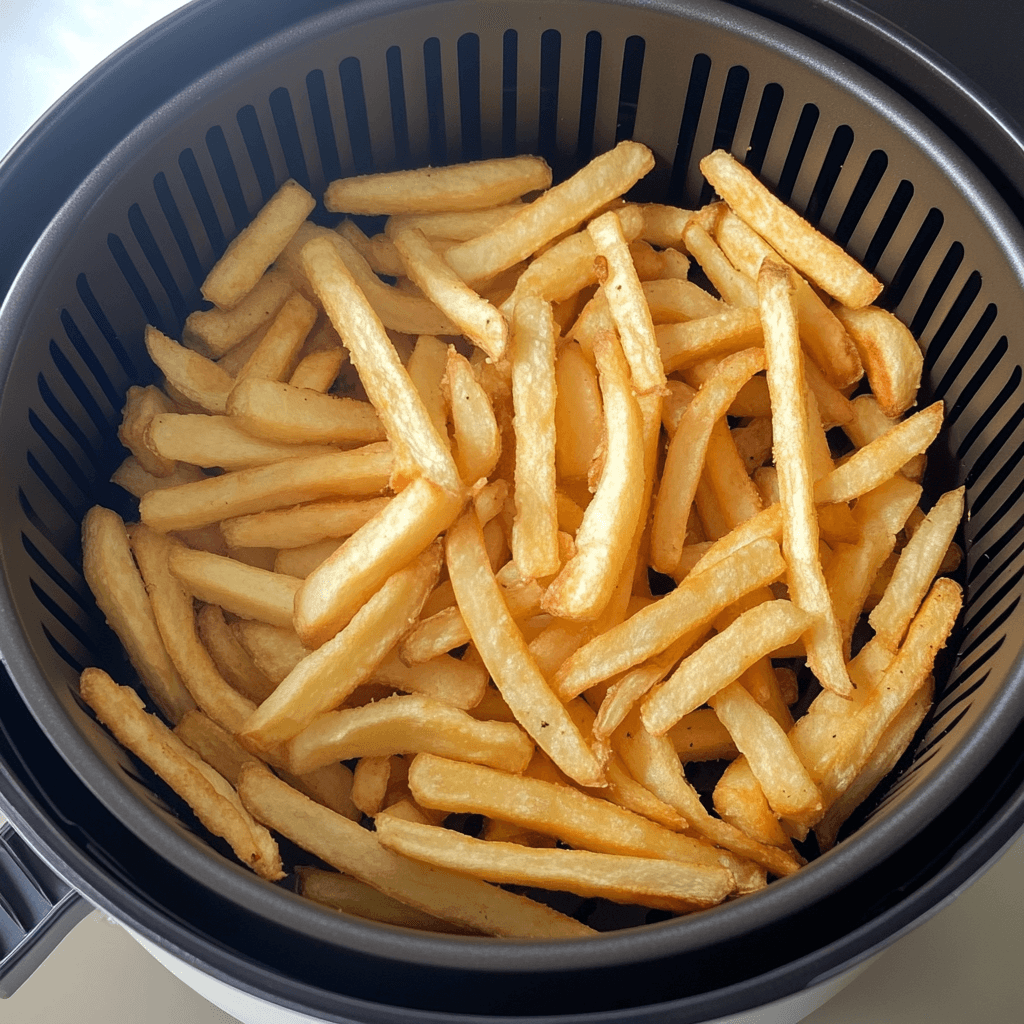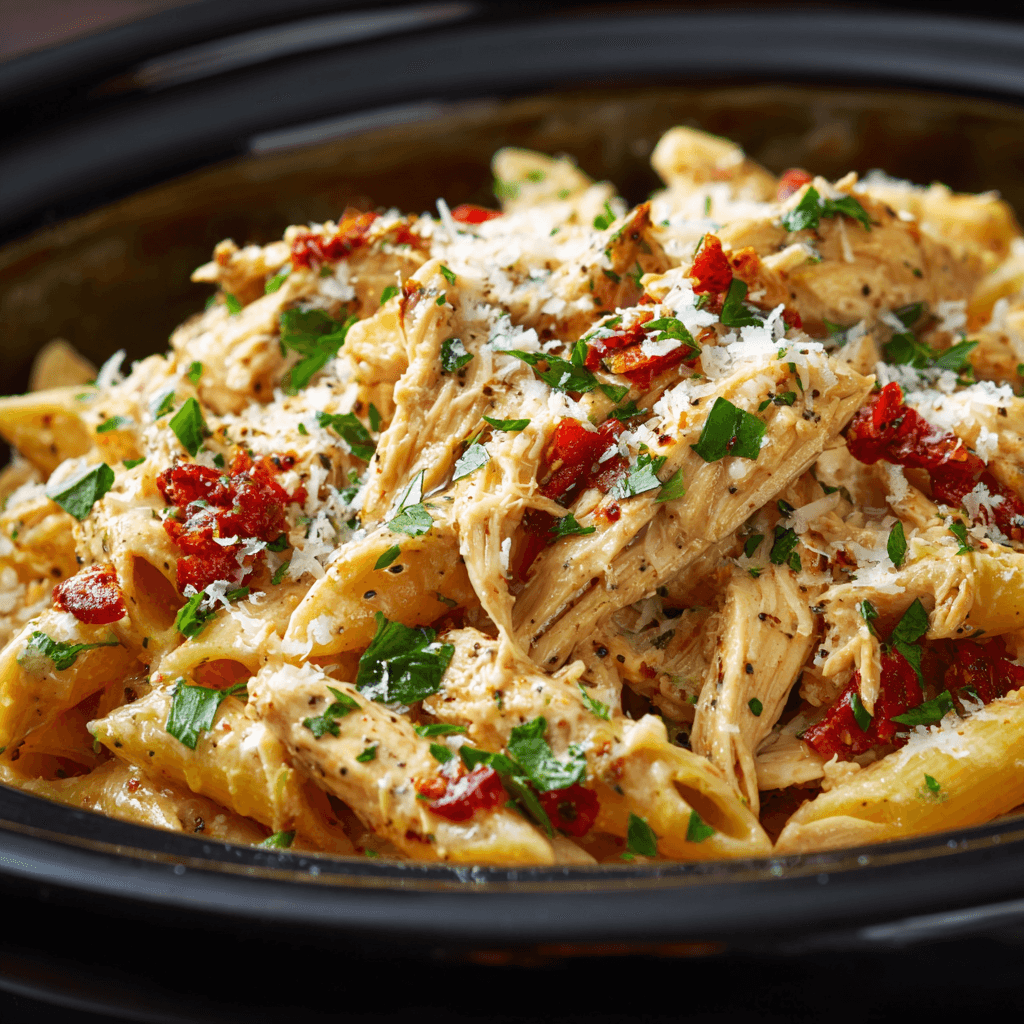Introduction to Teriyaki Chicken Recipe
What is a Teriyaki Chicken Recipe?
Teriyaki chicken is a classic dish featuring tender chicken coated in a glossy, flavorful sauce made from soy sauce, mirin, sugar, and other ingredients. This beloved recipe combines sweet and savory flavors with a touch of umami, creating a dish that is both comforting and versatile.
The History of Teriyaki Cuisine
The word “teriyaki” originates from the Japanese words teri (glaze) and yaki (grilling or broiling). Teriyaki cooking began in Japan as a way to prepare fish, but it evolved into a popular method for cooking meats like chicken. Over time, teriyaki became a global phenomenon, with variations appearing in Western cuisines.
Why Teriyaki Chicken is Loved Worldwide
Teriyaki chicken’s universal appeal lies in its balance of flavors and adaptability. The rich, sticky sauce pairs well with rice, noodles, or vegetables, making it a favorite in bento boxes, quick dinners, or restaurant menus. Its simple ingredients and straightforward preparation also make it accessible for cooks at any skill level.
Key Ingredients for Teriyaki Chicken
Traditional Ingredients in Teriyaki Sauce
- Soy Sauce: Provides the base of the sauce with a salty, umami flavor.
- Mirin: A sweet rice wine that adds depth and sweetness.
- Sugar or Honey: Sweetens the sauce and helps create its glossy texture.
- Ginger and Garlic: Bring aromatic warmth and complexity.
- Cornstarch or Arrowroot: Used to thicken the sauce for a rich consistency.
Essential Chicken Cuts
- Chicken Thighs: Preferred for their juiciness and ability to stay tender during cooking.
- Chicken Breasts: A leaner option that works well if cooked carefully to avoid dryness.
- Chicken Wings or Drumsticks: Excellent for appetizers or party dishes, as they absorb the sauce beautifully.
Ingredient Substitutes for Different Diets
- Low-Sodium Option: Use low-sodium soy sauce and reduce added sugar.
- Gluten-Free: Replace soy sauce with tamari or coconut aminos.
- Vegan Variation: Swap chicken for tofu, tempeh, or hearty vegetables like eggplant or mushrooms, and adjust the sauce accordingly.
With these key ingredients and variations, teriyaki chicken can be tailored to fit any dietary preference while retaining its signature flavor.
Choosing the Best Chicken Cuts
Boneless vs. Bone-In Chicken
- Boneless Chicken: Boneless cuts, such as thighs or breasts, are quick and easy to cook. They work best for stir-fries, skewers, or dishes where even cooking is important.
- Bone-In Chicken: Bone-in pieces, such as drumsticks or wings, retain more flavor and moisture. They are ideal for grilling or slow cooking.
Thighs vs. Breasts: Which is Better?
- Chicken Thighs: These are preferred for their juiciness and rich flavor. They’re more forgiving when cooked and pair beautifully with teriyaki sauce.
- Chicken Breasts: Leaner and milder in flavor, breasts are a healthier option but can dry out if overcooked. They require careful monitoring to stay tender.
Tips for Selecting Fresh and Organic Chicken
- Freshness: Choose chicken with a pinkish hue and avoid discoloration or slimy textures.
- Packaging: Ensure the seal is intact and check the expiration date.
- Organic Options: Opt for organic or free-range chicken whenever possible, as they often have better flavor and are raised without antibiotics or hormones.
The Science Behind Teriyaki Sauce
What Makes Teriyaki Sauce Special?
Teriyaki sauce is unique because of its glossy texture, balance of sweet and savory flavors, and ability to enhance the natural taste of the chicken. The combination of soy sauce, mirin, and sugar creates a harmonious blend that makes the dish irresistible.
Balancing Sweet, Salty, and Umami Flavors
- Sweetness: Comes from sugar, honey, or mirin, giving the sauce its signature glaze.
- Saltiness: Provided by soy sauce, which also brings umami depth.
- Umami: Enhanced by ginger, garlic, or even a splash of sake for a more robust flavor.
Homemade vs. Store-Bought Sauce
- Homemade Sauce: Allows you to control the flavor balance, adjust sweetness or saltiness, and use fresh ingredients for a more authentic taste.
- Store-Bought Sauce: Convenient for quick meals, but may contain preservatives and less natural flavor. Choose high-quality brands for the best results.
Equipment Needed for Cooking Teriyaki Chicken
Must-Have Tools and Utensils
- Nonstick Pan or Wok: Ideal for searing chicken and simmering the sauce evenly.
- Tongs or Spatula: For flipping and handling the chicken during cooking.
- Mixing Bowl: To prepare the marinade or sauce ingredients.
Optional Equipment for Efficiency
- Meat Thermometer: Ensures chicken is cooked to a safe internal temperature of 165°F (74°C).
- Rice Cooker: Perfect for preparing fluffy rice to accompany the chicken.
- Marinade Injector: Speeds up the process of infusing flavor into larger cuts of chicken.
Preparing Your Kitchen for Success
- Organize Ingredients: Measure and arrange everything before you begin cooking.
- Clean Workspace: Ensure your surfaces and utensils are clean and ready for use.
- Preheat Equipment: Heat your pan or grill to the required temperature for even cooking.
With the right chicken cuts, a perfect teriyaki sauce, and well-prepared equipment, you’re set to create a teriyaki chicken dish that’s both delicious and stress-free.
Preparing the Perfect Teriyaki Sauce
Classic Teriyaki Sauce Recipe
To make an authentic teriyaki sauce, combine the following ingredients:
- Soy Sauce: ½ cup
- Mirin: ¼ cup
- Sugar: 2 tablespoons
- Ginger (grated): 1 teaspoon
- Garlic (minced): 1 teaspoon
- Cornstarch (optional): 1 teaspoon mixed with water to thicken the sauce.
Simmer the ingredients in a saucepan over medium heat until the sugar dissolves and the sauce slightly thickens.
Adjusting the Sauce for Sweetness and Thickness
- For More Sweetness: Add honey, brown sugar, or maple syrup for a richer flavor.
- For More Thickness: Use a cornstarch slurry (1 part cornstarch mixed with 2 parts water) to achieve a glossy, thick texture.
- For a Thinner Sauce: Add a splash of water or chicken stock to dilute the sauce to your desired consistency.
Storing and Reusing Leftover Sauce
- Storage: Keep leftover sauce in an airtight container in the refrigerator for up to one week.
- Reuse: Reheat the sauce on low heat and use it for other dishes, such as stir-fries, rice bowls, or as a dipping sauce.
Cooking Methods for Teriyaki Chicken
Grilling for a Smoky Flavor
Grilling enhances the dish with a smoky aroma and slight char:
- Preheat the grill to medium-high heat and oil the grates.
- Grill marinated chicken for 5–7 minutes per side, basting with teriyaki sauce during the final minutes.
Pan-Frying for Quick Results
Pan-frying is the fastest way to prepare teriyaki chicken:
- Heat a nonstick pan over medium heat and add a splash of oil.
- Sear the chicken for 3–4 minutes on each side until golden brown.
- Add teriyaki sauce to the pan, reduce heat, and simmer until the chicken is fully cooked.
Oven-Baking for Even Cooking
Oven-baking is ideal for achieving consistent results:
- Preheat the oven to 375°F (190°C).
- Place the chicken in a baking dish and pour teriyaki sauce over it.
- Bake for 25–30 minutes, basting occasionally for a glossy finish.

Achieving the Perfect Glaze
How to Get the Iconic Teriyaki Shine
The signature teriyaki glaze comes from the balance of sugar and soy sauce, which caramelize as the sauce reduces. To achieve this:
- Cook the sauce over low to medium heat until it thickens and becomes glossy.
- Brush the sauce onto the chicken during the final stages of cooking for a vibrant shine.
Using Cornstarch vs. Traditional Methods
- Cornstarch Slurry: Mix 1 teaspoon of cornstarch with 2 teaspoons of water and add it to the sauce for a thick, shiny finish.
- Traditional Reduction: Simmer the sauce until it naturally reduces and thickens without additional starch.
Timing the Sauce Application
- Early Application: Add sauce during the cooking process for a deep, caramelized flavor.
- Final Basting: Apply a layer of sauce in the last few minutes of cooking to lock in the glaze and avoid burning.
By perfecting the teriyaki sauce, selecting the right cooking method, and mastering the glaze, you’ll create a teriyaki chicken dish that looks as good as it tastes.
Serving Suggestions for Teriyaki Chicken
Classic Pairings: Rice and Vegetables
- Steamed Rice: White or brown rice complements the sweet and savory flavors of teriyaki chicken, soaking up the rich sauce perfectly.
- Stir-Fried Vegetables: Serve with broccoli, carrots, snap peas, or bell peppers for a nutritious and colorful side.
- Noodles: Toss teriyaki chicken with soba or udon noodles for a hearty, filling meal.
Fusion Ideas: Tacos, Wraps, and Sandwiches
- Teriyaki Tacos: Use soft tortillas and add slaw, sesame seeds, and a drizzle of extra teriyaki sauce for an Asian-Mexican fusion.
- Lettuce Wraps: Wrap the chicken in crisp lettuce leaves for a lighter, keto-friendly option.
- Sandwiches: Layer teriyaki chicken on a toasted bun with grilled pineapple and a smear of mayo for a Hawaiian-inspired sandwich.
Garnishing for Visual Appeal
- Sesame Seeds: Sprinkle white or black sesame seeds for a nutty flavor and attractive contrast.
- Green Onions: Thinly sliced green onions add a fresh, vibrant touch.
- Fresh Herbs: Garnish with cilantro or parsley for added color and flavor.
Variations of Teriyaki Chicken Recipe
Keto-Friendly Teriyaki Chicken
- Low-Carb Sauce: Replace sugar with stevia or erythritol and use tamari or coconut aminos instead of soy sauce.
- Pairings: Serve with cauliflower rice or zucchini noodles for a keto-friendly meal.
Vegan Teriyaki Alternatives
- Protein Options: Swap chicken for tofu, tempeh, or jackfruit.
- Vegan Sauce: Ensure all sauce ingredients are plant-based, replacing honey with maple syrup or agave.
Spicy Teriyaki Chicken Recipe
- Add Heat: Incorporate sriracha, chili flakes, or gochujang into the teriyaki sauce for a spicy kick.
- Spicy Garnishes: Serve with fresh jalapeño slices or a drizzle of spicy mayo for extra heat.
Storing and Reheating Leftovers
Best Practices for Storage
- Refrigeration: Store cooked teriyaki chicken in an airtight container in the fridge for up to 4 days.
- Separate Components: If serving with rice or vegetables, store each item separately to maintain texture.
Reheating Tips Without Compromising Flavor
- Microwave: Heat in short intervals, covered with a damp paper towel, to keep the chicken moist.
- Stovetop: Warm chicken in a skillet over low heat, adding a splash of water or sauce to prevent drying out.
- Oven: Reheat at 350°F (175°C) for 10–15 minutes, covered with foil to retain moisture.
Freezing Teriyaki Chicken for Later Use
- Freezing: Place fully cooled chicken in a freezer-safe container or bag, removing as much air as possible. Freeze for up to 2 months.
- Thawing: Defrost in the fridge overnight before reheating.
By exploring these serving suggestions, recipe variations, and storage tips, you’ll make the most out of every teriyaki chicken meal, whether freshly prepared or enjoyed as leftovers.
Health Benefits of Teriyaki Chicken
Nutritional Breakdown
Teriyaki chicken provides a balanced mix of macronutrients:
- Protein: Chicken is a high-quality protein source essential for muscle repair and growth.
- Carbohydrates: The sauce contributes carbs due to sugar, but pairing it with brown rice or vegetables adds fiber for sustained energy.
- Fats: Using healthy oils like sesame or avocado oil keeps the dish heart-friendly.
Benefits of Key Ingredients
- Soy Sauce: Contains small amounts of antioxidants and contributes to umami flavor.
- Garlic and Ginger: Both are known for anti-inflammatory and immune-boosting properties.
- Chicken: Provides essential vitamins like B6 and B12, along with minerals such as zinc and iron.
Adjusting the Recipe for a Health-Conscious Approach
- Reduce Sodium: Use low-sodium soy sauce or tamari to cut down on salt.
- Lower Sugar: Substitute sugar with honey, maple syrup, or a natural sweetener like stevia.
- Lean Protein: Use skinless chicken breasts instead of thighs for a lower-fat option.
Common Mistakes to Avoid
Overcooking the Chicken
- Issue: Overcooking makes the chicken dry and tough.
- Solution: Cook to an internal temperature of 165°F (74°C) and allow the chicken to rest before serving.
Using Too Much Sauce
- Issue: Excess sauce can overpower the dish and make it overly sweet or salty.
- Solution: Use enough sauce to coat the chicken lightly and serve extra on the side for dipping.
Balancing the Sweetness and Saltiness
- Issue: An imbalance can ruin the flavor profile.
- Solution: Taste the sauce as you prepare it and adjust sugar or soy sauce gradually for the perfect balance.
FAQs About Teriyaki Chicken Recipe
What is teriyaki chicken sauce made of?
Traditional teriyaki sauce is made from soy sauce, mirin, sugar, and optional ingredients like garlic, ginger, or sake for added depth. It’s simmered to create a glossy, flavorful glaze.
Does teriyaki sauce go on before or after cooking?
Teriyaki sauce can be applied both ways. Use it as a marinade before cooking to infuse flavor and baste the chicken during or after cooking to create a shiny glaze.
Is there a difference between teriyaki marinade and sauce?
Yes, a marinade is typically thinner and used to tenderize and flavor the chicken before cooking. Teriyaki sauce is thicker and is often used for glazing or as a topping.
Can you use teriyaki sauce straight from the bottle?
Yes, most bottled teriyaki sauces are ready to use. However, you can enhance the flavor by simmering it with fresh garlic, ginger, or a splash of soy sauce and honey.
What’s the best way to store leftovers?
Keep leftovers in an airtight container in the fridge for up to 4 days. Reheat in the microwave or oven until hot and bubbly. For food safety tips, refer to USDA guidelines on leftovers .
To enhance the “Teriyaki Chicken Recipe” article, consider including internal links to related content from the sitemap. These links can provide readers with additional valuable insights:
- When discussing choosing chicken cuts, link to Mouthwatering Chicken Tenderloin Recipes to Try Today to inspire readers with more chicken options.
- In the section about storing and reheating leftovers, link to The Ultimate Guide to Rotisserie Chicken Recipes to explore other ways of utilizing leftover chicken creatively.
- While highlighting fusion ideas, link to The Ultimate Guide to Delicious Chicken Pasta Recipes for readers who might want to incorporate teriyaki chicken into pasta dishes.
These internal links can improve site navigation and encourage readers to explore more recipes, enhancing their overall experience.
Conclusion: Why You’ll Love the Teriyaki Chicken Recipe
Summarizing the Recipe’s Benefits
The teriyaki chicken recipe is a perfect blend of savory, sweet, and umami flavors, making it a universally loved dish. It’s versatile, easy to prepare, and pairs well with a variety of sides, from steamed rice to stir-fried vegetables. Whether you grill, pan-fry, or bake, this dish delivers a consistently delicious meal that suits any occasion.
Encouraging Creativity with the Dish
This recipe serves as a base for endless possibilities. Customize the sauce to your taste by adjusting sweetness or adding spice, or try creative variations like keto-friendly or vegan alternatives. Experiment with different pairings, such as noodles, tacos, or wraps, to reinvent the dish for your family and guests.
Sharing the Joy of Teriyaki with Loved Ones
Cooking and sharing teriyaki chicken with loved ones is a great way to bring people together. Its bold and comforting flavors appeal to all ages, making it perfect for family dinners, meal prep, or celebrations. Encourage friends and family to try this recipe and make it their own by exploring new twists and garnishes.
In every bite, teriyaki chicken offers a delightful experience, combining tradition with versatility. It’s a recipe that’s sure to become a household favorite!






2 thoughts on “The Ultimate Teriyaki Chicken Recipe: Step-by-Step Guide”
Comments are closed.